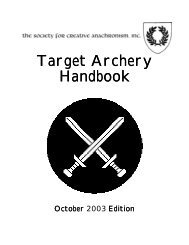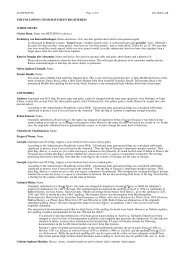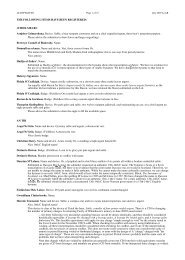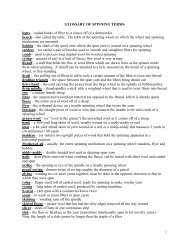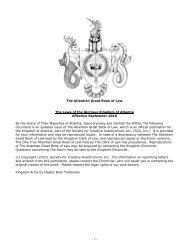The Standards for Evaluation of Names and Armory - SCA Heraldry
The Standards for Evaluation of Names and Armory - SCA Heraldry
The Standards for Evaluation of Names and Armory - SCA Heraldry
You also want an ePaper? Increase the reach of your titles
YUMPU automatically turns print PDFs into web optimized ePapers that Google loves.
considered the same.<strong>The</strong> <strong>St<strong>and</strong>ards</strong> <strong>for</strong> <strong>Evaluation</strong> <strong>of</strong> <strong>Names</strong> <strong>and</strong> <strong>Armory</strong>:<strong>The</strong> Rules <strong>for</strong> SubmissionsFor example, Per chevron gules <strong>and</strong> argent, a pale azure has one DC from Chevronelly gules <strong>and</strong> argent,a pale azure. Quarterly Or <strong>and</strong> sable, a fleur-de-lys gules has one DC from Checky Or <strong>and</strong> sable, afleur-de-lys gules. Per pale azure <strong>and</strong> argent has one DC from Per pale azure <strong>and</strong> bendy argent <strong>and</strong>gules. In each case, the change <strong>of</strong> number <strong>of</strong> pieces is significant.For example, Gyronny <strong>of</strong> six ermine <strong>and</strong> vert, a roundel sable does not have a DC from Gyronny (<strong>of</strong>eight) ermine <strong>and</strong> vert, a roundel sable. <strong>The</strong>re is no DC between Barry wavy <strong>of</strong> six argent <strong>and</strong> azure, adolphin gules <strong>and</strong> the same design drawn with more traits, <strong>and</strong> we generally do not blazon that difference.<strong>The</strong> one exception is party <strong>of</strong> six, which is divided in a different pattern (effectively per fess <strong>and</strong> paly <strong>of</strong>three) <strong>and</strong> was seen as a distinct field division in period. <strong>The</strong>re<strong>for</strong>e, it has one DC from checky <strong>and</strong>designs that create large numbers <strong>of</strong> lozenges (such as paly bendy). However, it does not have a DC fromdesigns such as Paly <strong>and</strong> per fess which create the same overall impression.e. Fieldless <strong>Armory</strong>: A piece <strong>of</strong> fieldless armory automatically has one distinct change (DC) from anyother armory, fielded or fieldless.Tinctureless armory, as described in A.3.A.2, is treated as fieldless armory <strong>for</strong> this purpose. However, noDC may be given <strong>for</strong> tincture <strong>of</strong> charges when comparing a tinctureless badge to any other design,including changes <strong>of</strong> tincture due to addition <strong>of</strong> lines <strong>of</strong> division.For example, (Fieldless) A mullet purpure has a DC <strong>for</strong> fieldlessness from (Fieldless) A mullet <strong>of</strong> sixpoints purpure, but no other DCs. For example, Per fess gules <strong>and</strong> argent, a lion counterchanged has aDC <strong>for</strong> tincturelessness from (Tinctureless) A lion but no other DCs <strong>for</strong> tincture, even though one <strong>of</strong> thelions is divided per fess.2. Adding or Removing a Charge Group: Adding or removing a secondary, tertiary, or overall charge groupis a distinct change (DC). <strong>The</strong> addition or removal <strong>of</strong> a primary charge gives greater difference <strong>and</strong> isdescribed under A.5.E.1 above. We count additions <strong>and</strong> removals in terms <strong>of</strong> the charge groups they affect,so that adding or removing multiple charges from a single group is only one distinct change. Adding orremoving charges from multiple charge groups may give multiple distinct changes.For example, Sable, a ram argent has one DC from Sable, a ram argent <strong>and</strong> a chief Or <strong>and</strong> from Sable, aram argent <strong>and</strong> overall a bend Or. In each case one charge group is removed. Sable, a ram argent <strong>and</strong> achief, overall a bend Or has two DCs from Sable, a ram argent. Similarly, Sable, a ram argent <strong>and</strong> on achief Or three roses sable also has two DCs from Sable, a ram argent. In each case two charge groups areadded. Sable, a ram argent <strong>and</strong> a chief Or has two DCs from Sable, a ram argent <strong>and</strong> overall a bend Or, asa secondary charge group has been added <strong>and</strong> an overall charge group removed.As discussed in A.5.C.2 above, when two pieces <strong>of</strong> armory have the same number <strong>of</strong> secondary chargegroups, they may not be considered to have added or removed a secondary charge group, even if thosesecondary charge groups are different kinds <strong>of</strong> secondary groups.For example, Sable, a lion argent <strong>and</strong> a chief Or has only one DC from Sable, a lion argent <strong>and</strong> in canton amullet Or, <strong>for</strong> the change in the type <strong>of</strong> the secondary charge (under A.5.G.4 below), rather than one DC <strong>for</strong>removing the chief <strong>and</strong> a second DC <strong>for</strong> adding the mullet.As discussed in A.5.C.2 above, tertiary charge groups are considered comparable <strong>for</strong> the purposes <strong>of</strong> thisrule if they are on the same type <strong>of</strong> underlying charge group (primary, secondary, or overall). <strong>The</strong> additionor removal <strong>of</strong> comparable tertiary charge groups is a distinct change.<strong>St<strong>and</strong>ards</strong> <strong>for</strong> <strong>Evaluation</strong> <strong>of</strong> <strong>Names</strong> <strong>and</strong> <strong>Armory</strong> – April 29, 2012 - Page 61 <strong>of</strong> 73



